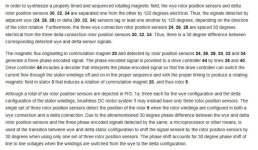larsb
1 MW
I found info that a switch from star to delta connection for a motor gives a phase delay of 30 electrical degrees. I think it is explained by a different coils induction from the three coils connections in delta as compared to two coils connections in star.
If there's a good reference to this with explanation then please link it!
 could this explain why original hall sensors are off for the Revolt RV120?
could this explain why original hall sensors are off for the Revolt RV120?
My thinking is:
Tuned setting for phase shift when optimized with an adaptto controller was 24 degrees, error margin to 30 is 6 degrees and the sensors were offset by some millimeter in the slots which could cause these 6 degrees. It roughly fits..
My guess halls for the RV120 are set neutral (as they are placed 120 degrees apart in the middle of the slots - no physical shift) and should be shifted 30 electrical degrees. That would be a really basic error if this is the case.
I will try the outside halls with 30(electrical degrees)/7(pole pairs)=4.3 degrees mechanical delayed hall location.
If there's a good reference to this with explanation then please link it!
My thinking is:
Tuned setting for phase shift when optimized with an adaptto controller was 24 degrees, error margin to 30 is 6 degrees and the sensors were offset by some millimeter in the slots which could cause these 6 degrees. It roughly fits..
My guess halls for the RV120 are set neutral (as they are placed 120 degrees apart in the middle of the slots - no physical shift) and should be shifted 30 electrical degrees. That would be a really basic error if this is the case.
I will try the outside halls with 30(electrical degrees)/7(pole pairs)=4.3 degrees mechanical delayed hall location.





